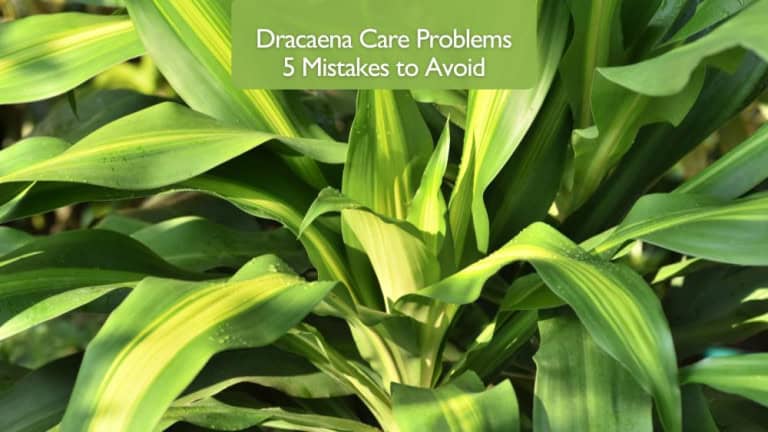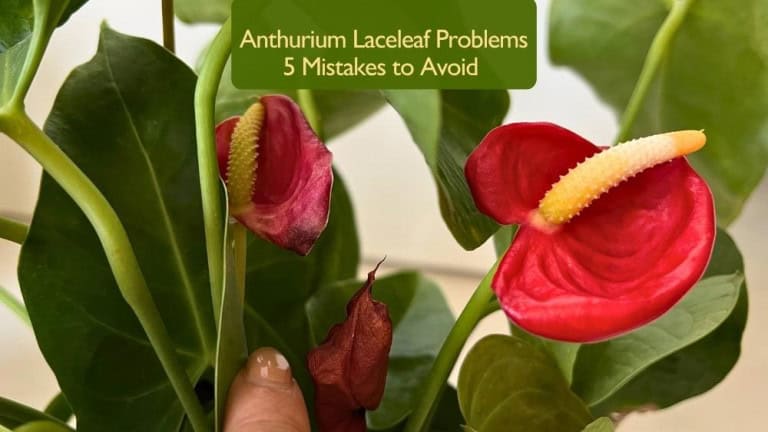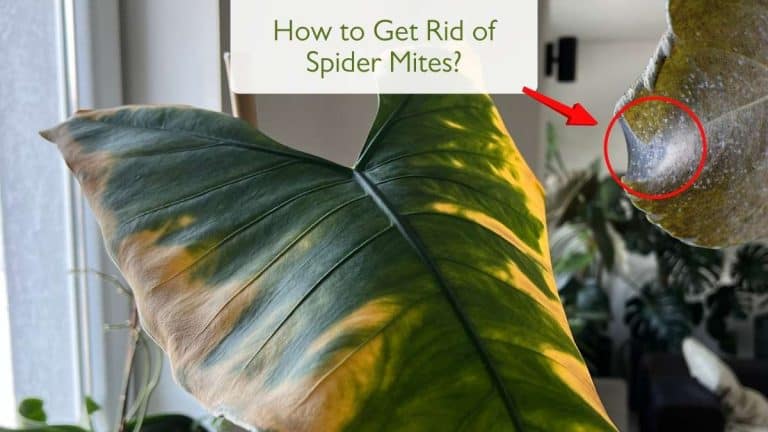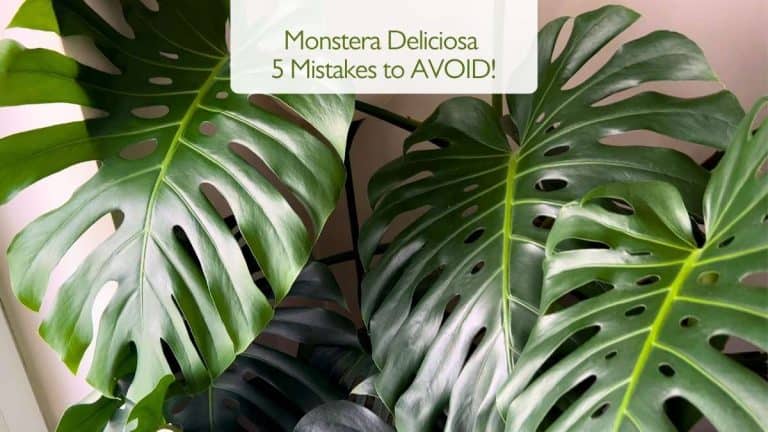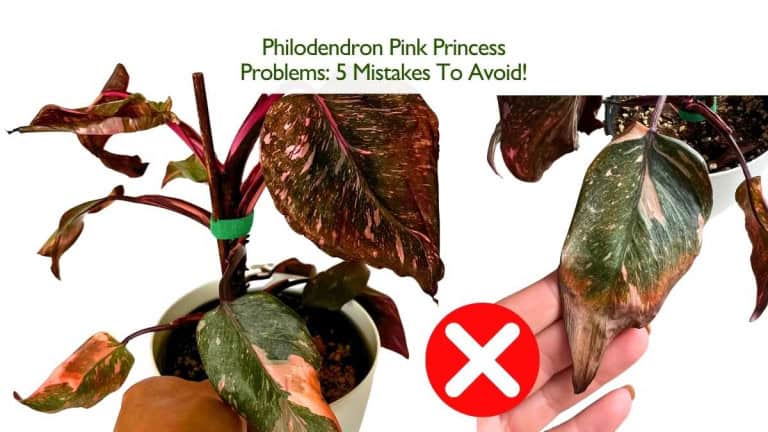Dracaena Care Problems – 5 Mistakes to Avoid & How to Fix Them
If your Dracaena is developing brown leaf tips, yellowing leaves, or has stopped growing, you’re likely dealing with one of the most common Dracaena care problems. These tropical plants are elegant and resilient but can be sensitive when their environment isn’t quite right.
In this post, I’ll go through five mistakes to avoid and the best ways to fix them, so your Dracaena stays strong, glossy, and full of life.
If you prefer visuals, I suggest watching my video below about Dracaena Care Problems:
Click here to watch my video on YouTube
💡 For a complete beginner’s guide, read Dracaena Plant Care: Everything You Need to Know – it covers light, watering, and soil basics to help you understand the ideal growing conditions before tackling problems.
And if your plant already shows brown or yellow edges, you’ll also find this related article helpful:
👉 How to Fix Yellow and Brown Edges on Dracaena Leaves: Causes, Solutions, and Prevention
Now, let’s fix your Dracaena step by step!
Mistake #1 – Watering the Wrong Way
Watering is the number one cause of Dracaena care problems, and most of them come down to three key mistakes: overwatering, poor water quality, and cold water shock.
Overwatering
Dracaena roots are extremely sensitive to excess moisture, and overwatering is one of the most common Dracaena care problems plant owners face. These tropical plants naturally grow in environments where the soil drains quickly, allowing air to reach the roots. When grown indoors, heavy or constantly damp soil traps water around the roots, cutting off their oxygen supply.
As a result, the roots begin to suffocate and rot, leading to yellowing leaves, mushy stems, soft trunks, and drooping growth. In severe cases, the rot spreads upward, and the plant can collapse completely even though the soil looks moist.
How to recognize overwatering:
- Lower leaves turn yellow and fall off easily.
- The soil stays wet for more than a week after watering.
- The pot feels unusually heavy.
- There’s a musty or sour smell coming from the soil.
How to fix it:
- Check the roots immediately. Remove the plant from the pot and inspect the root system. Healthy roots are firm and white; rotting roots are brown, black, or slimy.
- Trim damaged roots using sterilized scissors and repot the plant into fresh, well-draining soil.
- Use a pot with drainage holes to allow excess water to escape.
- Adjust your watering schedule – wait until the top 2 inches of soil are completely dry before watering again.
- If your room has low light or cooler temperatures, reduce watering frequency even further since the soil takes longer to dry.
🌿 Pro tip: Dracaenas prefer being slightly underwatered rather than overwatered. Their thick stems store moisture, allowing them to bounce back from dry soil, but root rot is almost impossible to reverse once it spreads.

Tap Water Sensitivity
Another common cause of Dracaena care problems is the type of water you use. Many plant lovers don’t realize that tap water often contains fluoride, chlorine, and other minerals that can harm sensitive houseplants like Dracaena. Over time, these chemicals build up in the soil and start to damage the roots, showing their effects on the leaves, most often as brown, crispy tips or patchy discoloration along the edges.
Dracaenas are especially vulnerable because their long, sword-shaped leaves easily display even the slightest stress. If you’ve noticed dry, brown edges despite watering correctly, the culprit might be fluoride toxicity rather than underwatering or low humidity.
How to fix it:
- Switch to clean water sources. Use filtered, distilled, or rainwater whenever possible. These options are free from harmful chemicals and much gentler on Dracaena’s roots.
- Avoid softened water. Water softened by salt systems adds sodium, which can further stress Dracaena’s root system and worsen leaf burn.
- Flush the soil occasionally. Every few months, pour plenty of distilled water through the pot to rinse out any accumulated salts or fluoride residues.
By simply changing your water habits, you can prevent one of the most overlooked Dracaena care problems and keep your plant’s leaves glossy, hydrated, and healthy for years to come.
❄️ Cold Water Shock
It might surprise you, but even the temperature of the water you use can trigger serious Dracaena care problems. These tropical plants are native to warm, humid regions, where rainwater and soil temperatures remain mild year-round. When you water your Dracaena with cold water straight from the tap, it shocks the roots, causing an instant temperature drop in the root zone.
That stress can make your plant’s growth slow down dramatically, and you may notice drooping leaves, pale new growth, or curling edges. In severe cases, cold shock also weakens the plant’s natural defenses, making it more vulnerable to root rot and bacterial infections.
How to Fix: Use room-temperature water, ideally between 65°F and 75°F (18–24°C). Let the water sit out for a few hours before watering; this allows it to reach ambient temperature and avoid one of dracaena care problems.
Mistake #2 – Fertilizer Imbalance
Another frequent cause of Dracaena care problems is fertilizer misuse – either giving too much or too little. Because Dracaenas grow slowly and have modest nutrient needs, they don’t require heavy feeding like some fast-growing tropicals. Overzealous fertilizing, however, is one of the quickest ways to damage them.
When fertilizer is applied too often or in strong concentrations, mineral salts accumulate in the soil. These salts draw moisture away from the roots and burn delicate tissues, causing brown leaf tips, yellow patches, or stunted new growth. Conversely, if the plant receives no nutrients for months, it may look pale, weak, and unable to produce healthy new leaves.
How to maintain balance:
- Feed lightly and consistently. During spring and summer – the active growing season, use a balanced liquid fertilizer diluted to half strength. Apply it once a month right after watering to avoid root shock.
- Pause in fall and winter. As growth slows, the plant’s nutrient demand drops sharply. Continuing to fertilize in this period leads to buildup and one of the most common Dracaena care problems: salt toxicity.
- Flush the soil regularly. Every few months, water the pot thoroughly with distilled or rainwater, letting excess drain away. This washes out trapped salts that can harm the roots.
- Watch for warning signs. Brown tips combined with a white crust on the soil surface indicate over-fertilization. Remove the top layer of soil and replace it with fresh, clean mix if buildup appears.
🌿 Extra tip: Organic options such as worm castings tea or seaweed extract can provide gentle nourishment without the risk of chemical burn. They also improve soil structure and microbial activity, keeping your Dracaena’s root system strong and balanced.
Mistake #3 – Using the Wrong Pot or Soil Mix
Choosing the right pot and soil might seem like a simple task, but it’s one of the most underestimated causes of Dracaena care problems. These plants are surprisingly particular about their root environment, and even small mistakes in pot choice, soil texture, or repotting frequency can lead to stress and decline.
Dracaena roots prefer stability and airflow. When the soil is too compact or the pot holds excess water, oxygen can’t circulate properly, creating a breeding ground for root rot. Likewise, repotting too often or using a pot that’s too large can disrupt root health and slow the plant’s growth dramatically.

⚠️ Common Mistakes to Avoid
- Repotting too frequently. Dracaenas dislike being disturbed. Unless roots are visibly pushing out of the pot’s drainage holes, there’s no need to repot more than once every 2–3 years.
- Using deep, narrow pots. Deep pots retain water at the bottom where roots rarely reach, which can lead to root suffocation and decay. Instead, choose a wide, shallow container that matches your plant’s root structure.
- Heavy, compacted soil. Standard garden soil or peat-heavy mixes trap too much moisture. This is one of the most common yet hidden Dracaena care problems among indoor gardeners.
The Ideal Setup to avoid Dracaena care problems
- Use a light, well-draining mix. Combine equal parts of potting soil, perlite, and coarse sand. This blend keeps moisture levels balanced while allowing airflow to the roots.
- Add drainage. Ensure your pot has at least one large hole at the bottom, and place a layer of pebbles or clay balls before adding soil.
- Stabilize your plant. Once potted, avoid moving your Dracaena too often. It thrives best when left in one spot with consistent light and temperature.
💡 Pro Tip: If your Dracaena looks droopy or has stopped growing after repotting, it might be adjusting to its new environment. Give it time and resist the urge to water immediately. Wait until the top of the soil feels dry before the first watering.
By providing the right soil texture and avoiding frequent repotting, you’ll eliminate one of the major Dracaena care problems that lead to long-term root stress. Remember: Dracaenas prefer consistency over change, a stable environment encourages strong roots and lush, upright foliage.
Mistake #4 – Dusty or Dirty Leaves
t might not seem like a serious issue, but dust buildup on leaves is another subtle cause of Dracaena care problems that many plant owners overlook. Dracaenas have long, broad leaves that easily collect dust, especially when kept near windows, vents, or in rooms with low air circulation.
If ignored for months, dirty leaves can also attract spider mites, mealybugs, and thrips, which thrive in still, dusty conditions. These pests feed on the plant’s sap, leaving small yellow dots or sticky residue behind – another reason why keeping the foliage clean is essential for long-term plant health.
How to clean your Dracaena:
- Every 2–3 months, give it a gentle shower with lukewarm water to wash off dust.
- Alternatively, wipe each leaf using a damp microfiber cloth.
- Add a few drops of neem oil to the water for a natural shine and pest protection.
This routine not only keeps your plant looking healthy but also prevents fungal spores and insects from settling on the leaf surface.
If you’d like to see how I clean my plants and make their leaves naturally glossy, watch my video below:
Click here to watch the video on YouTube
Mistake #5. Low Humidity Levels
Dry indoor air is one of the most underestimated causes of Dracaena care problems. While Dracaenas are adaptable and can survive in average home humidity, they truly thrive in slightly more humid conditions; ideally between 40% and 60%.
When the air becomes too dry, especially during winter heating season, you may notice brown, crispy leaf tips, curling leaves, and weak new growth. These are classic signs of low humidity stress. Over time, dry air also makes your plant more susceptible to spider mites, which multiply quickly in arid environments.
Dracaenas lose moisture through tiny pores on their leaves, and when the air around them is too dry, they can’t replace that water fast enough. The result is dehydrated tissue, visible as dull or brittle edges. Thankfully, restoring humidity is simple and makes a huge difference in preventing long-term Dracaena care problems.

How to Increase Humidity Naturally
- Group plants together. Plants release moisture through transpiration. By placing several plants close to each other, you create a small pocket of higher humidity – a natural micro-climate your Dracaena will love.
- Use a pebble tray. Fill a shallow tray with pebbles and water, and place your pot on top (without submerging the roots). As the water evaporates, it increases the humidity around the plant.
- Add a humidifier. If your home is especially dry in winter, a small room humidifier can keep moisture levels consistent. This is one of the most effective long-term solutions.
- Avoid drafts and heating vents. Constant exposure to warm or dry air currents dehydrates the plant faster. Keep your Dracaena away from radiators and direct airflow.
💡 Pro Tip: Avoid misting. Although it might seem like a quick fix, misting raises humidity for only a few minutes and can actually lead to fungal spots on the leaves. It’s better to rely on steady moisture sources like trays or humidifiers for lasting results.
When humidity levels are right, your Dracaena’s leaves will feel smooth and flexible, not dry or papery. Maintaining balanced moisture in the air prevents one of the most frequent Dracaena care problems and keeps your plant looking lush, glossy, and full of life all year long.

Final Thoughts – Dracaena Care Problems
Caring for Dracaena is easy once you understand its rhythm. By fixing these simple mistakes, your plant will reward you with strong, glossy leaves and steady growth all year round.
If you’re struggling with similar issues, check out Dracaena Plant Care: Everything You Need to Know for the foundational guide, and How to Fix Yellow and Brown Edges on Dracaena Leaves for a deep dive into leaf damage recovery.
🌿 Related Topics
- Top 8 Air Purifying Houseplants
- Winter Plant Care Tips: 5 Mistakes to Avoid
- Neem Oil for Houseplants: The Complete Guide
- Pet-Friendly Houseplants: Toxic vs. Non-Toxic Plants – Which Are Safe?
Explore More Music for Your Plants & Stay Connected!
Check out my Playlist: Music for Plants and find the perfect tunes to help your plants and yourself thrive.
Don’t forget to visit my YouTube Channel Plant House & Garden and subscribe – your support means the world to me!
Connect with me on social media for more plant care tips and music updates: Instagram | Facebook | X | Pinterest | Reddit | TikTok
Love plants? Love music? Don’t miss out on new updates – hit subscribe and follow now to keep your plants happy and your space vibrant!

